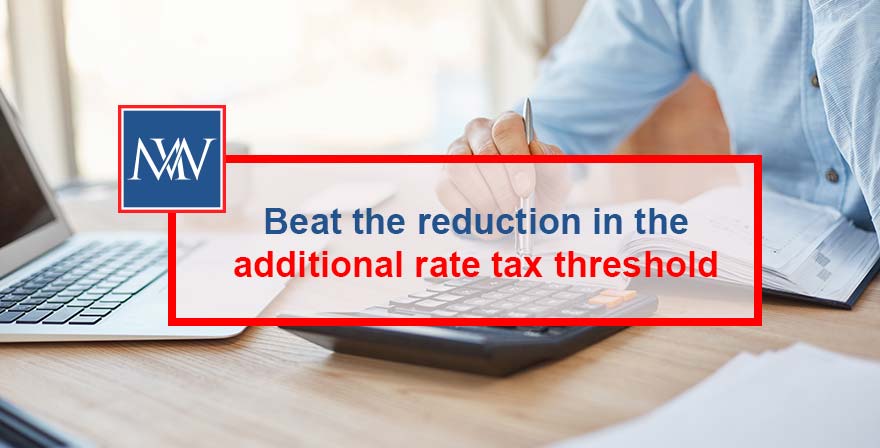
Beat the reduction in the additional rate tax threshold
For a brief period it seemed that the days were numbered for the additional rate of tax following the announcement in the ill-fated mini Budget that it was to be scrapped. Like much of the mini Budget, its planned abolition was swiftly reversed. However, this was not the end of the additional rate tax saga; the Autumn Statement delivered a further plot twist with the announcement that the additional rate threshold is to fall to £125,140 from 6 April 2023.
Why £125,140?
The new threshold is the point at which the personal allowance is completely lost. The personal allowance (which is frozen at its current level of £12,570 until April 2028) is reduced by £1 for every £2 by which income exceeds £100,000.
The combination of the abatement of the allowance and the 40% tax rate that applies at this level means the marginal rate of tax in this band (£100,000 to £125,140) is 60%. Lowering the additional rate threshold to below £125,140 would raise the marginal rate of tax in the abatement zone above 60%.
Additional rate tax landscape
Until 5 April 2023, the additional rate threshold remains at £150,000. This creates the slightly anomalous effect that the marginal rate on income between £100,000 and £125,140 is 60%. Once the personal allowance has been lost, the marginal rate drops to 40% on income between £125,140 and £150,000, rising to 45% on income in excess of £150,000.
From 6 April 2023, this second 40% band will be lost – the new additional rate threshold will mean that income is taxed at 45% once the personal allowance has been fully abated.
Where the income in question is dividend income, it is taxed at 33.75% where it falls in the higher rate band and at 39.35% where it falls in the additional rate band. In the personal allowance abatement zone, the marginal rate is 50.6%.
Planning opportunities
The new lower additional rate threshold does not come into effect until 6 April 2023. This may provide the opportunity to advance income so that it is taxed at the higher rate in 2022/23 rather than at the additional rate in 2023/24. However, care must be taken not to move income from the additional rate band to the personal allowance abatement zone where the marginal rate is higher.
Case study
Tim is the director of T limited. He has income of £130,000 a year. He was planning on paying a dividend of £20,000 in May 2023. If he does so, the dividend will be taxed at the additional rate of 39.35%, meaning Tim will pay tax of £7,870 on the dividend.
However, if retained profits permit, he could instead pay the dividend before 6 April 2023 so that it is taxable in 2022/23 rather than 2023/24. This would mean that it would be taxed at the upper dividend rate of 33.75% rather than at the dividend additional rate of 39.35%. Consequently, the tax payable on the dividend would be £6,750. Advancing the dividend would save him tax of £1,120. On the downside, the tax would be payable a year earlier.
If, however, Tim has income of £100,000 in 2022/23 before paying the dividend and expects to have income of £130,000 in 2023/24 before paying a dividend, it is not worthwhile advancing the dividend payment to before 6 April 2023. If he does this, he will increase his income for 2022/23 to £120,000, meaning he will lose £10,000 of his personal allowance. The tax hit of doing so is more than paying tax at the additional rate. Consequently, it is better for him to pay the dividend on or after 6 April 2023.
Need Accountancy Support?
For information on bespoke training, or if you have any other questions for Makesworth Accountant, please fill in your details below
















 151
151